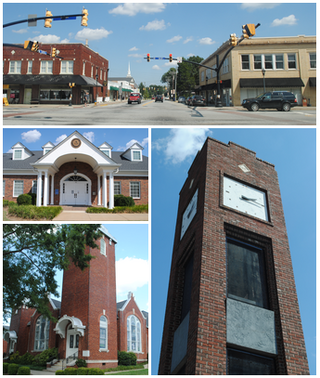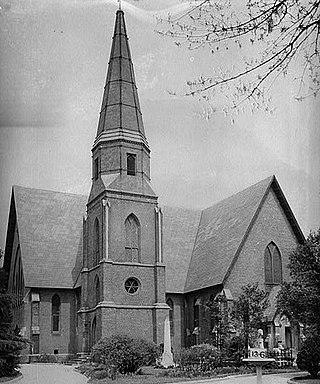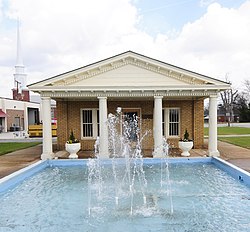
Simpsonville is a city in Greenville County, South Carolina, United States. It is part of the Greenville, SC Metropolitan Statistical Area. The population was 23,354 at the 2020 census, up from 18,238 in the 2010 census. Simpsonville is part of the "Golden Strip", along with Mauldin and Fountain Inn, an area which is noted for having low unemployment due to a diversity of industries including H.B. Fuller, KEMET, Sealed Air and Milliken. It is the 23rd-most populous city in South Carolina.

Fountain Inn is a city in Greenville and Laurens counties in the U.S. state of South Carolina. The population was 10,416 at the 2020 census, up from 7,799 in 2010. It is part of the Greenville-Mauldin-Easley Metropolitan Statistical Area.

Greer is a city in the Greenville and Spartanburg counties in the U.S. state of South Carolina. As of the 2020 census, the population was 35,308, making it the 14th-most populous city in South Carolina. Greer is included in the Greenville-Anderson-Greer, SC Metropolitan Statistical Area, which is part of the Greenville-Spartanburg-Anderson, SC Combined Statistical Area in Upstate South Carolina.

Verni Robert Quillen was an American journalist and humorist who for more than a quarter century was "one of the leading purveyors of village nostalgia" from his home in Fountain Inn, South Carolina. In 2012, his office and library was listed on the National Register of Historic Places.

Poinsett Bridge is the oldest bridge in South Carolina and perhaps in the entire southeastern United States. Named for Joel Roberts Poinsett, it was built in 1820 as part of a road from Columbia, South Carolina, to Saluda Mountain. The stone bridge, which includes a 14-foot (4.3 m) Gothic arch and stretches 130 feet (40 m) over Little Gap Creek, may have been designed by Robert Mills, architect of the Washington Monument. Though no longer in use, the bridge remains largely intact and is part of the 400-acre (161.9 ha) Poinsett Bridge Heritage Preserve. There is a nature trail a few hundred yards from the bridge. The bridge, about which ghost stories have been told for decades, is located off U.S. Highway 25 north of Greenville, South Carolina. The bridge was added to the National Register of Historic Places in 1970.

Broad Margin is the name given to the private residence originally commissioned by Gabrielle and Charlcey Austin. It is located in Greenville, South Carolina, United States, was designed by Frank Lloyd Wright and was built by local builder Harold T. Newton in 1954. It is one of two buildings designed by Wright in South Carolina.

Cannon Building in Fountain Inn, South Carolina is a building built in 1880. It was listed on the National Register of Historic Places in 2005.

Christ Church (Episcopal) is an Episcopal church in Greenville, South Carolina, United States. which was consecrated in 1854. The church and its courtyard are listed on the National Register of Historic Places as Christ Church (Episcopal) and Churchyard. It is the oldest organized religious body and the oldest church building remaining in Greenville.

This is a list of the National Register of Historic Places listings in Greenville County, South Carolina outside the city of Greenville.

Anderson Downtown Historic District in Anderson, South Carolina, originally built in the late 19th century, is a historic district that was listed on the National Register of Historic Places in 1979.

This is a list of the National Register of Historic Places listings in Greenville, South Carolina.

Fairview Presbyterian Church is a historic church listed on the National Register of Historic Places near Fountain Inn, South Carolina. The present two-story building, constructed in 1858 in the Greek Revival style, was the fourth building constructed by the church, which was founded in 1786.

The Fountain Fox Beattie House, the home of Greenville Woman's Club from 1950 to 2014, is a historic house in Greenville, South Carolina. It was listed on the National Register of Historic Places in 1974.

The Fountain Inn High School was a building that formerly served as a high school, located in Fountain Inn, South Carolina. It was designed by the Greenville, South Carolina based architectural firm Beacham and LeGrand and built in 1939. An example of New Deal-era design in the Moderne style, its construction was undertaken using grants by the Public Works Administration program.

Woodside Cotton Mill Village Historic District is a national historic district located in Greenville County, South Carolina. The district encompasses 278 contributing buildings and 2 contributing sites in an early 20th century urban South Carolina textile mill village. Centered on a mill founded by John T. Woodside in 1902, the district is located just west of the city limits of Greenville and is largely intact despite modernizations made by a succession of mill and home owners. The mill itself is a rectangular, brick, four-story building designed by J.E. Sirrine and built between 1902 and 1912. Eventually the mill became the largest cotton mill under one roof in the United States and one of the largest in the world.

Fountain Inn Principal's House and Teacherage is a historic home and teacherage located at Fountain Inn, Greenville County, South Carolina. It was built in 1935 as a home for teachers, and is the only remaining building associated with the Fountain Inn Negro School complex. The complex once included a grade school built in 1928, a high school built in 1930, a library, and the Clayton "Peg Leg" Bates Gymnasium, built in 1942. The school and its appurtenant buildings served the educational needs of Fountain Inn's African American community until the students of this community were enrolled in Fountain Inn High School in the 1960s.

The Lanneau-Norwood House is a historic, late 19th-century house on Belmont Avenue in Greenville, South Carolina. The house is an outstanding example of Second Empire architecture in the American South and is one of the last surviving Victorian-era homes in Greenville. The property was added to the National Register of Historic Places in 1982.

Greenville County Courthouse, also known as Greenville Family Courts Building, is a historic courthouse located at Greenville, South Carolina. It was built in 1918, and is a Beaux-Arts style brick and concrete building with terra cotta trim. The building consists of a three-story front section, with an eight-story tower behind. The building served as the courthouse for Greenville County until 1950 when the court was moved to a new building. The Family Court of Greenville County was located then in the building and remained there until 1991.

The James A. Fulmer House is a historic house at 303 North Main Street in Fountain Inn, South Carolina. It is a 1+1⁄2 story brick building, with a side gable roof and projecting gable section on the left front. It is basically Tudor Revival in character, but also exhibits Craftsman details such as extended eaves and exposed rafter ends. Built in 1932 for a prominent businessman, it is one of the city's finest examples of Tudor Revival architecture, and a rare example of design work by Leila Ross Wilburn, one of the first female pattern-book architects.






















